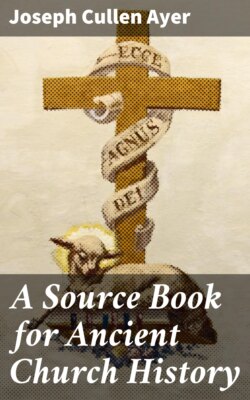Читать книгу A Source Book for Ancient Church History - Joseph Cullen Ayer - Страница 93
На сайте Литреса книга снята с продажи.
(f) Irenæus. Adv. Hær., I, 1. (MSG, 7:445 f.)
ОглавлениеThe following passage appears, from the context, to have been written with the teaching of Ptolemæus especially in mind. It should [pg 094] be compared with the account further on in the same book, I, 11: 1–3. The syzygies are characteristic of the Valentinian teaching, and the symbolism of marriage plays an important part in the “system” of all the Valentinians. In the words of Duchesne (Hist. ancienne de l'église, sixth ed., p. 171): “Valentinian Gnosticism is from one end to the other a ‘marriage Gnosticism.’ From the most abstract origins of being to their end, there are only syzygies, marriages, and generations.” For the connection between these conceptions and antinomianism, see Irenæus, Adv. Hær., I, 6:3 f. For their sacramental application, ibid., I, 21:3. Cf. I, 13:3, a passage which seems to belong to the sacrament of the bridal chamber.
They [the Valentinians] say that in the invisible and ineffable heights above there exists a certain perfect, pre-existent Eon, and him they call Proarche, Propator, and Bythos; and that he is invisible and that nothing is able to comprehend him. Since he is comprehended by no one, and is invisible, eternal, and unbegotten, he was in silence and profound quiescence in the boundless ages. There existed along with him Ennœa, whom they call Charis and Sige. And at a certain time this Bythos determined to send forth from himself the beginnings of all things, and just as seed he wished to send forth this emanation, and he deposited it in the womb of her who was with him, even of Sige. She then received this seed, and becoming pregnant, generated Nous, who was both similar and equal to him who had sent him forth47 and alone comprehended his father's greatness. This Nous they also call Monogenes and Father and the Beginning of all Things. Along with him was also sent forth Aletheia; and these four constituted the first and first-begotten Pythagorean Tetrad, which also they denominate the root of all things. For there are first Bythos and Sige, and then Nous and Aletheia. And Monogenes, when he perceived for what purpose he had been sent forth, also himself sent forth Logos and Zoe, being the father of all those who are to come after him, and the beginning and fashioning of the entire [pg 095] pleroma. From Logos and Zoe were sent forth, by a conjunction, Anthropos and Ecclesia, and thus were formed the first-begotten Ogdoad, the root and substance of all things, called among them by four names; namely, Bythos, Nous, Logos, and Anthropos. For each of these is at once masculine and feminine, as follows: Propator was united by a conjunction with his Ennœa, then Monogenes (i.e., Nous) with Aletheia, Logos with Zoe, Anthropos with Ecclesia.
